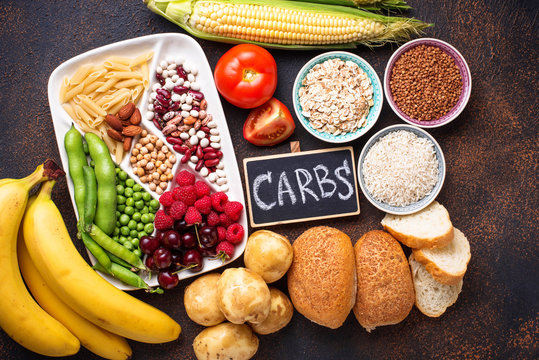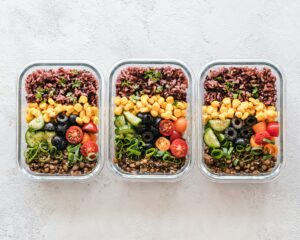Carbohydrates are one of the main nutrients in your diet. Except for fiber, carbohydrates yield 4 calories per gram (similar to protein). They also play an important role in providing energy for your body. Here’s some information about the three main types of carbohydrates.
What are Carbohydrates?
-
Sugars – These are simple carbohydrates found naturally in fruits, vegetables, and dairy products. This can also be added to foods and beverages during processing or preparation. I.e., glucose, fructose, and lactose.
-
Starches – Complex carbohydrates (grains, potatoes, and legumes) are made of long chains of glucose molecules. These starches take longer to digest and provide a more sustained release of energy compared to sugars.
-
Fiber: Fiber is also a complex carbohydrate that cannot be fully digested by our bodies. It’s found in plant-based foods like fruits, vegetables, whole grains, nuts, and seeds. Fiber aids in digestion, promotes bowel regularity, and helps with maintaining a healthy weight.
For athletes, inadequate carbohydrate intake negatively impacts the benefits from training and performance that a person could achieve. It’s important to include a variety of carbohydrates in your diet. You should focus on unprocessed foods and balancing your other nutrient intake to maintain a healthy diet.
The Structure of Carbohydrates
The Glycemic Index (GI) is a measure that indicates how fast a carbohydrate-containing food raises blood glucose levels after consumption. Foods are compared to glucose on a scale with a value of 100. Carbohydrates with a higher GI (70 or above) can cause a rapid spike in blood sugar levels, while those lower on the scale lead to a more gradual response.
Simple carbohydrates like table sugar, juice, sweetened soda, and candy have higher GI values. While complex carbohydrates and high-fiber foods like whole grains, legumes, and vegetables are lower on the GI scale.
Easily digestible carbs provide quick energy when consumed before exercise, and after exercise. They also help replenish glycogen stores by providing immediate glucose.

Glycemic Index (GI)
A carbohydrate’s GI measures how quickly it raises an individual’s glucose levels when consumed alone. The GI scale compares all carbohydrates to glucose, which is given a value of 100 (Harvard Medical School, 2015).
Blood sugar levels can rise rapidly from carbohydrates with GI values of 70 or higher, whereas foods with GI values of 60 and lower can have a much slower rise. Table sugar, juice, sweetened soda, and candy are generally higher on the GI scale than most complex carbohydrates and high-fiber foods (such as whole grains, legumes, and vegetables).
For athletes, higher GI foods can be beneficial during pre-training and post-training periods. As an easy source of fuel before training, easy-to-digest carbohydrates provide immediate glucose for rapid glycogen replenishment in the post-training period.

|
Category |
Examples |
|
Low GI foods (55 or less) |
Most non-starchy vegetables and whole grains, beans, cow’s milk |
|
Medium GI foods (56–69) |
Macaroni and cheese, raisins, hamburger bun, pineapple, banana |
|
High GI foods (70 or above) |
Glucose, hard candy, instant rice, sports drinks |
|
Data from Burke et al., 2011. |
|
Glycemic Load (GL)
The Glycemic Load (GL) accounts for both a food’s Glycemic Index (GI) and the typical serving size, providing a more accurate measure of the food’s effect on blood glucose. For example, popcorn has a high GI of 72, but a 1-cup serving has a low GL, containing only 30 calories and 6g of carbohydrates. This does not raise blood glucose substantially.
Rather than focusing on your GI alone, consider the type of carbohydrate (simple vs. complex), serving size, and presence of fat and protein. This gives a fuller understanding of a food’s glycemic response.
Your GI/GL may only be meaningful in specific contexts. Diabetics may also find GI/GL values useful. But, their total carbohydrate intake, as well as all macronutrients and needs, are more important.

Dietary Carbohydrate Needs
Carbohydrate needs vary among individuals. This depends on the factors: size, energy requirements, physical activity, and medical conditions. Despite popular low-carb and ketogenic diets, remember that carbohydrates are still vital for optimal performance in life and exercise. Studies have shown that reduced carbohydrate intake can have negative effects on both high-intensity and endurance exercise performance.
Studies by Burke et al. (2017), Cermak et al. (2013), and Stepto et al. (2016) have demonstrated that low-carb diets can impair maximal effort during high-intensity exercise as well as performance in endurance sports. If you aim to optimize sports performance or build muscle, then you will benefit from consuming adequate carbohydrates to fuel your activity. The Acceptable Macronutrient Distribution Range (AMDR) provides a recommended range of carbohydrate intake. It suggests that 45% to 65% of calories should come from carbohydrates. Also, the AMDR recommends at least an intake of 130 grams of carbohydrates per day, based on a 2,000-calorie diet (U.S. Department of Agriculture, 2015).
It is important to note that carbohydrate requirements for active individuals depend on the factors: type, duration, and activity intensity. This is another reason why seeking guidance from nutrition professionals can be beneficial in tailoring carbohydrate intake to individual needs.
|
Activity |
Recommended Carbohydrate per Day |
|
Light exercise |
3–5 g/kg of body weight |
|
Moderately intense exercise: 1–2 hours per day, 5–6 days per week |
5–7 g/kg of body weight |
|
Moderately high-intensity endurance exercise: 1–3 hours per day; 5–6 days per week |
6–10 g/kg of body weight |
|
Moderate to high-intensity: > 3 hours per day; 2 sessions per day, 5–6 days per week |
8–10 g/kg of body weight |
|
Source: Burke et al., 2011; Karpinski & Rosenbloom, 2017. |
|
When to have Carbs? Before, During and After Exercise.
Pre-Exercise Intake
The consumption of carbohydrates before intense and long-duration exercise is essential. It helps to replenish glycogen stores that may be depleted after an overnight fast, providing the necessary fuel for performance.
During Exercise Intake
As glycogen stores diminish during exercise, ingesting carbohydrates helps maintain stable blood glucose levels and supplies energy to muscles for prolonged activity.
Post-Exercise Intake
Consuming carbohydrates and proteins post-exercise aids in recovery. It enables the body to replenish glycogen and promotes muscle protein synthesis, where new muscle proteins form, resulting in muscle growth or repair.
Research Support
Studies have shown that carbohydrate intake during endurance sports can improve performance and extend time until exhaustion (Currell & Jeukendrup, 2008; Patterson & Gray, 2007).

Conclusion…
Carbohydrates are essential nutrients that provide energy for the body. Most types of carbs yield 4 calories per gram. They come in three main forms. Sugars (fruits, vegetables, and dairy), starches (grains, potatoes, and legumes), and fiber (plant-based).
The Glycemic Index (GI) measures how carbohydrates raise your glucose level. The Glycemic Load (GL) also considers serving size for a more accurate effect on blood sugar.
Athletes may enjoy high-GI foods for quick energy and glycogen replenishment. Carbohydrate needs vary by individual, but they are crucial for both daily life and exercise. Carbs before, during, and after exercise help maintain energy, improve performance, and recovery. It’s important to balance carbohydrate intake with other nutrients and consider dietary needs.







